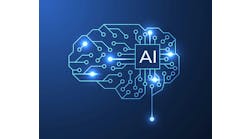Advantech’s Mike Berryman led a panel discussion on the common pain points in industrial operations that can be suitably addressed with AI. Joining him were (top to bottom) Mark Baybutt of AMP Robotics, Tom Arthur of Dianomic, and Neil Chen of Advantech.
“Smart machines are driving the new era of factory automation,” said Andrea Nemeth, European IIoT marketer and session host for the Advantech Connect Online Partner Conference session, “Smart Machine Maintenance & Prediction.” The session explored how machine intelligence and AI are shaping that new era. The four sessions focused on technology trends and new products, edge and cloud computing, and artificial intelligence for machine maintenance and predictive analysis.
Daniel Hsu, senior manager within the Industrial-IoT Group at Advantech, started off with a discussion about how the Internet of Things (IoT) has changed the machine industry and where cloud technology, edge intelligence and artificial intelligence (AI) are accelerating smart manufacturing applications. Smart manufacturing is predicted to grow significantly in the next five years, Hsu said.
“In the past 10 years, IoT has transformed the machine industry to move forward into a digital age,” Hsu said. “In recent years, we can see the cloud is transforming itself, and there is more cloud technology being pushed toward edge intelligence.”
Technology advances have led to an architecture transformation between the edge and cloud computing, with parts of the edge looking more and more like the cloud. “’Edge cloud’ will be one of the key elements to support edge intelligence,” Hsu said. The drivers for edge cloud, he noted, are varied connectivity in applications; the requirement for operational real-time decision making; the use of localized computing power; new storage and security needs; and applications with intermittent power.
Edge to cloud and industrial AI
Hsu highlighted a few of Advantech’s products for facilitating edge intelligence. The WISE-PaaS Marketplace is a cloud service and management portal, including in-house and industrial apps. With InsightAPM, Advantech offers a package of vertical solutions, including WISE-EdgeLink and WebAccess/SCADA, which supports hundreds of protocols to connect to individual machines.
“No matter what kind of PLC, controller or machine you own, all the data from the field can be collected through the Advantech edge and transmitted to the WISE-PaaS cloud. WISE-PaaS InsightAPM is very good at utilizing all the data in WISE-PaaS,” Hsu said.
With a strong demand for machine intelligence, many more edge-computer applications are being deployed in the field, Hsu said. “It’s really a challenge to manage all the edge computers in the field,” he added. “So Advantech launched the WISE-PaaS DeviceOn iBMC service with edge intelligence tools.” It enables out-of-band (OOB) manageability on Advantech edge computers.
Hsu also discussed field applications for industrial AI. “AI technology is a very good tool for enhanced inspection efficiency. With deep-learning technologies, AI can handle complicated jobs, such as materials service checking and analyzing image data very quickly,” Hsu said. Advantech’s AI solution, WISE-PaaS/AIFS AI framework service, includes different levels of AI development services. The platform can perform AI model training and auto retraining in order to improve the efficiency and the accuracy of AI models. AIFS can connect to a public, on-premise or hybrid cloud to manage the AI resources for computing.
Advantech is using the system, which combines edge intelligence and industrial AI, at its own Taiwan factory for deep soldering quality checks. “In order to improve the efficiency and the accuracy of inspection, the operator and the production engineer need to continuously review and label miss and overkill data,” Hsu said. AIFS can not only improve the quality on a production line, but it is also prime for scaling. “It can duplicate AI models and centralized maintenance on several production lines,” he said. The Taiwan factory saw a 30% efficiency increase with the use of the artificial intelligence to monitor quality.
The future of machine AI and compounded intelligence
The final panel discussion of the session also focused on machine AI. Mike Berryman, director of technical services and solutions, Advantech North America and panel moderator, started the conversation by asking about common business problems that are prime candidates for machine AI, and where to find the typical pain points in setting up a new application.
Mark Baybutt of AMP Robotics thinks the convergence of AI, machine learning and robotics offers opportunities to automate tasks that are labor intensive, high cost, inconsistent and limiting. AMP Robotics has found success with this in the recycling industry. “The tasks asked of humans in this industry are truly the definition of dull, dirty and dangerous,” Baybutt said, “exactly the application space to employ AI and machine learning to improve overall working conditions.” Investing deeply in a framework and pipeline to quickly train and adapt its neural network as it learns the landscape of consumer packaging has been successful for AMP Robotics.
Its fleet of deployed systems can also compound intelligence across the system. “This likens to taking knowledge from the best individuals in our industry and combining their knowledge into one, then being able to distribute that knowledge to our network of systems,” Baybutt said.
Machine learning is prime for predictive maintenance, Tom Arthur, CEO of Dianomic, said. Common pain points in edge machine learning are gathering and labeling data. “Labeling data usually requires some tribal knowledge,” Arthur said. “So someone needs to understand the machine and how it’s operated to properly label data.” A much bigger problem, he notes, though, is scaling. Supporting the lifecycle of hundreds or thousands of machines is a challenge, Arthur said.
As a success case, he pointed to a predictive maintenance AI application at an oil bottling plant that uses centrifuges to remove unwanted particles from the oil before bottling. AI models help predict maintenance on the centrifuges and optimize the valve that lets out the particles. Every time the valve opens, it also releases some oil. “So what is the proper optimal operation of a valve to run a centrifuge safely, while maximizing the gross margin and producing the most food oil you can?” Arthur asked. AI models are helping to answer that question.
Hybrid models and synthetic data
Where is the future of machine AI heading? Neil Chen, senior manager of the video solution division at Advantech, thinks AI will become a central part of the whole factory. “OT and IT and a hybrid fusion architecture are the way forward,” Chen said.
One of the biggest challenges Dianomics’ Arthur sees moving forward is gaining access to data from all the many different communication protocols. “We believe the best way to solve the diversity problem is through an open-source project,” Arthur said. Along with OSIsoft, Google and others, his company has started a project through the Linux Foundation called LF Edge. “LF Edge is designed to connect to any machine or sensor, aggregate the data from those machines, process that data on the edge, including running the machine learning model, doing alerts and even more importantly then, integrating that data to the cloud or to any operation system that the factory already uses,” Arthur said.
Dianomic is also helping manufacturers build models more quickly by using synthetic vibration data as a starting point for machine learning algorithms. Manufacturers can then start with synthetic data on the machines and identify faults from predetermined levels. “Over time you can get actual data from those machines, label that data, and improve the models on your specific machine,” Arthur said. “But day one you start with an anomaly detection system using machine learning that can identify these faults, and in some cases, the cause of the faults.”
Autonomous manufacturing and new business models
Two other presentations during the session focused on intelligent equipment for the semiconductor industry and the move toward autonomous manufacturing and a panel discussion on how to accelerate the adoption of smart manufacturing. Ryan Yip, R&D director for ASM Pacific Technology, said the synergy of IoT and AI will enable equipment to collect and analyze data and make decisions based on the analysis. “It’s a passive step toward autonomous manufacturing,” Yip said. “To build equipment intelligence, machine learning and deep learning are the key drivers.”
Yip outlined three different levels of equipment intelligence. The first level is assisted intelligence, which includes quality predictions, machine health monitoring and anomaly detection. The second level is augmented intelligence to perform root cause analysis and improve maintenance scheduling. The most advanced level is autonomous intelligence, where equipment operation is self-controlled, regulated and optimized without human intervention.
Marco Zampolli, senior product sales manager and solution architect for the Industrial-IoT Group of Advantech Europe, moderated the second panel discussion. Two main topics included the importance of data management and new business models for machine builders. Zampolli welcomed Frank Kuitems, head of Industry 4.0 at Atos; Maarten Wijffelaars, managing director of Sensor to Data BV; and Sam Chuo, business development manager for Advantech. According to Chuo, some of the challenges to better data management for machine builders include the need for an integrated solution from edge to cloud; better development resources to meet client demands; more long-term support partnerships; and better infrastructure framework for scalability. He encouraged equipment builders to think about how they manage data hierarchy.
Fundamental infrastructure changes may also be pushing new business models for machine builders. Kuitems predicted that business models will shift from “product-centric to service-centric models,” from “mass production to mass personalization,” and from “ownership to pay as you go” models. “So the machine builders receive their income based on the usage by the customer,” he said. Wijffelaars also noted the importance that existing installations are not forgotten. For machines that haven’t reached the end of useful life, the industry needs to develop a solution so existing machine can also be smart.
View the entirety of the Smart Machine Maintenance & Prediction Track on demand.
Access the entire agenda of the Advantech Connect conference.





